今天完成的事情:今天学了js的HTML DOM 集合和HTML DOM 节点列表以及对象和prototype相关
明天计划的事情:继续学习js的后续内容
遇到的问题:概念比较难懂,后续会在看一下详细了解一下
收获:
HTMLCollection 对象
getElementsByTagName() 方法返回 HTMLCollection 对象。
HTMLCollection 对象类似包含 HTML 元素的一个数组。
以下代码获取文档所有的 <p> 元素:
<h2>JavaScript HTML DOM</h2>
<p>Hello World!</p>
<p>Hello Runoob!</p>
<p id="demo"></p>
<script>
var myCollection = document.getElementsByTagName("p");
document.getElementById("demo").innerHTML = "第二个段落的内容为:<span style='color:red;'> " + myCollection[1].innerHTML + '</span>';
</script>
运行结果
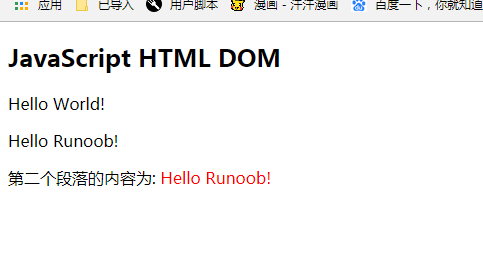
HTMLCollection 对象 length 属性
<h2>JavaScript HTML DOM</h2>
<p>Hello World!</p>
<p>Hello Runoob!</p>
<p id="demo"></p>
<script>
var myCollection = document.getElementsByTagName("p");
document.getElementById("demo").innerHTML = "文档包含" + myCollection.length + " 个段落。";
</script>
运行结果
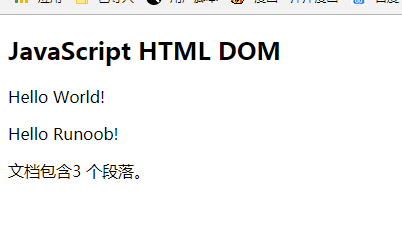
修改所有 <p> 元素的背景颜色:
<h2>JavaScript HTML DOM</h2>
<p>Hello World!</p>
<p>Hello Runoob!</p>
<p>点击按钮修改 p 元素的背景颜色。</p>
<button onclick="myFunction()">点我</button>
<script>
function myFunction() {
var myCollection = document.getElementsByTagName("p");
var i;
for (i = 0; i < myCollection.length; i++) {
myCollection[i].style.color = "red";
}
}
</script>
运行结果
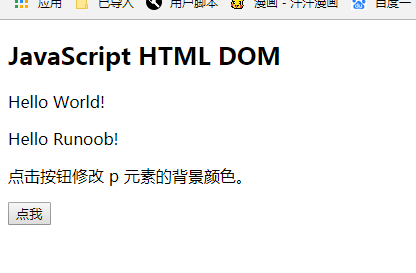
点击之后
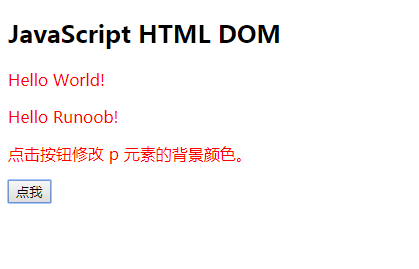
注意
HTMLCollection 不是一个数组!
HTMLCollection 看起来可能是一个数组,但其实不是。
你可以像数组一样,使用索引来获取元素。
HTMLCollection 无法使用数组的方法: valueOf(), pop(), push(), 或 join() 。
NodeList 对象是一个从文档中获取的节点列表 (集合) 。
NodeList 对象类似 HTMLCollection 对象。
一些旧版本浏览器中的方法(如:getElementsByClassName())返回的是 NodeList 对象,而不是 HTMLCollection 对象。
所有浏览器的 childNodes 属性返回的是 NodeList 对象。
大部分浏览器的 querySelectorAll() 返回 NodeList 对象。
JavaScript 对象
JavaScript 中的所有事物都是对象:字符串、数值、数组、函数...
此外,JavaScript 允许自定义对象。
创建 JavaScript 对象
通过 JavaScript,您能够定义并创建自己的对象。
创建新对象有两种不同的方法:
定义并创建对象的实例
使用函数来定义对象,然后创建新的对象实例
创建直接的实例
这个例子创建了对象的一个新实例,并向其添加了四个属性:
<script>
var person = new Object();
person.firstname = "John";
person.lastname = "Doe";
person.age = 50;
person.eyecolor = "blue";
document.write(person.firstname + " is " + person.age + " years old.");
</script>
运行结果

替代语法(使用对象 literals):
<script>
person = { firstname: "John", lastname: "Doe", age: 50, eyecolor: "blue" }
document.write(person.firstname + " is " + person.age + " years old.");
</script>
运行结果同样的

使用对象构造器使用函数来构造对象:
<script>
function person(firstname, lastname, age, eyecolor) {
this.firstname = firstname;
this.lastname = lastname;
this.age = age;
this.eyecolor = eyecolor;
}
myFather = new person("John", "Doe", 50, "blue");
document.write(myFather.firstname + " is " + myFather.age + " years old.");
</script>
运行结果同样的

把方法添加到 JavaScript 对象
方法只不过是附加在对象上的函数。
在构造器函数内部定义对象的方法:
<script>
function person(firstname, lastname, age, eyecolor) {
this.firstname = firstname;
this.lastname = lastname;
this.age = age;
this.eyecolor = eyecolor;
this.changeName = changeName;
function changeName(name) {
this.lastname = name;
}
}
myMother = new person("Sally", "Rally", 48, "green");
myMother.changeName("Doe");
document.write(myMother.lastname);
</script>
运行结果
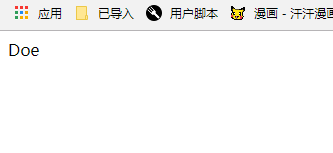
JavaScript for...in 循环
JavaScript for...in 语句循环遍历对象的属性。
<p>点击下面的按钮,循环遍历对象 "person" 的属性。</p>
<button onclick="myFunction()">点击这里</button>
<p id="demo"></p>
<script>
function myFunction() {
var x;
var txt = "";
var person = { fname: "Bill", lname: "Gates", age: 56 };
for (x in person) {
txt = txt + person[x];
}
document.getElementById("demo").innerHTML = txt;
}
</script>
运行结果
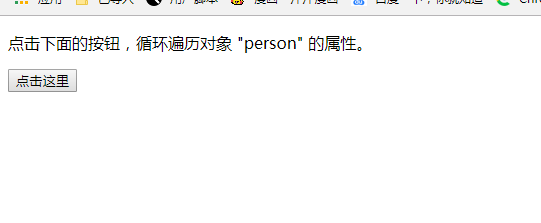
点击
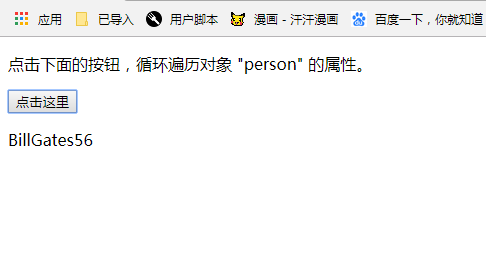
JavaScript prototype(原型对象)
所有的 JavaScript 对象都会从一个 prototype(原型对象)中继承属性和方法。
<h2>JavaScript 对象</h2>
<p id="demo"></p>
<script>
function Person(first, last, age, eye) {
this.firstName = first;
this.lastName = last;
this.age = age;
this.eyeColor = eye;
}
var myFather = new Person("John", "Doe", 50, "blue");
var myMother = new Person("Sally", "Rally", 48, "green");
document.getElementById("demo").innerHTML =
"我的父亲年龄是 " + myFather.age + "。我的母亲年龄是 " + myMother.age;
</script>
运行结果
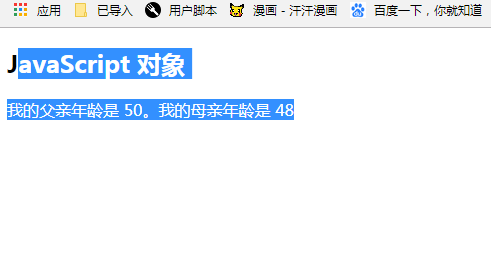
一个已存在的对象构造器中是不能添加新的属性的:例如
<h2>JavaScript 对象</h2>
<p>你无法给构造函数添加新的属性。</p>
<p id="demo"></p>
<script>
function Person(first, last, age, eye) {
this.firstName = first;
this.lastName = last;
this.age = age;
this.eyeColor = eye;
}
Person.nationality = "English";
var myFather = new Person("John", "Doe", 50, "blue");
var myMother = new Person("Sally", "Rally", 48, "green");
document.getElementById("demo").innerHTML =
"我父亲的国籍是 " + myFather.nationality;
</script>
运行结果
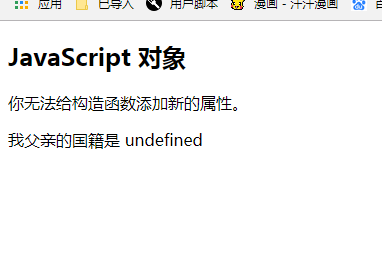
要添加一个新的属性需要在在构造器函数中添加:
<h2>JavaScript 对象</h2>
<p id="demo"></p>
<script>
function Person(first, last, age, eye) {
this.firstName = first;
this.lastName = last;
this.age = age;
this.eyeColor = eye;
this.nationality = "English";
}
var myFather = new Person("John", "Doe", 50, "blue");
var myMother = new Person("Sally", "Rally", 48, "green");
document.getElementById("demo").innerHTML =
"我父亲的国籍是 " + myFather.nationality + "。我母亲的国籍是 " + myMother.nationality;
</script>
运行结果
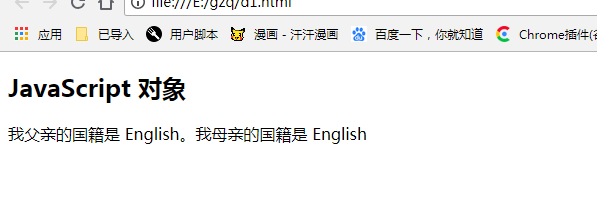
prototype 继承
所有的 JavaScript 对象都会从一个 prototype(原型对象)中继承属性和方法:
Date 对象从 Date.prototype 继承。
Array 对象从 Array.prototype 继承。
Person 对象从 Person.prototype 继承。
所有 JavaScript 中的对象都是位于原型链顶端的 Object 的实例。
JavaScript 对象有一个指向一个原型对象的链。当试图访问一个对象的属性时,它不仅仅在该对象上搜寻,还会搜寻该对象的原型,以及该对象的原型的原型,依次层层向上搜索,直到找到一个名字匹配的属性或到达原型链的末尾。
Date 对象, Array 对象, 以及 Person 对象从 Object.prototype 继承。
添加属性和方法
有的时候我们想要在所有已经存在的对象添加新的属性或方法。
另外,有时候我们想要在对象的构造函数中添加属性或方法。
使用 prototype 属性就可以给对象的构造函数添加新的属性:
<h2>JavaScript 对象</h2>
<p id="demo"></p>
<script>
function Person(first, last, age, eye) {
this.firstName = first;
this.lastName = last;
this.age = age;
this.eyeColor = eye;
}
Person.prototype.nationality = "English";
var myFather = new Person("John", "Doe", 50, "blue");
document.getElementById("demo").innerHTML =
"我父亲对国籍是 " + myFather.nationality;
</script>
运行结果
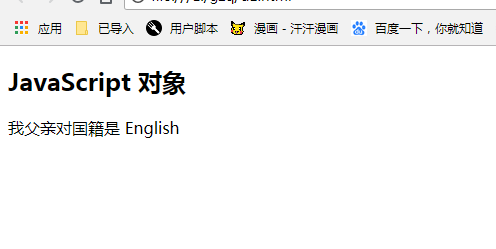
当然我们也可以使用 prototype 属性就可以给对象的构造函数添加新的方法:
<h2>JavaScript 对象</h2>
<p id="demo"></p>
<script>
function Person(first, last, age, eye) {
this.firstName = first;
this.lastName = last;
this.age = age;
this.eyeColor = eye;
}
Person.prototype.name = function () {
return this.firstName + " " + this.lastName
};
var myFather = new Person("John", "Doe", 50, "blue");
document.getElementById("demo").innerHTML =
"我对父亲是 " + myFather.name();
</script>
运行结果
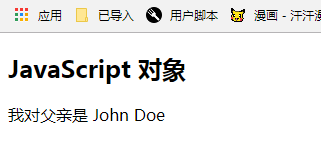
明天回顾一下前面的内容然后继续后面的部分




















评论